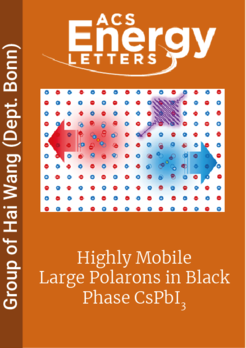Highly Mobile Large Polarons in Black Phase CsPbI3
Perovskites are a recently re-discovered material class with excellent optoelectronic properties. For example, solar cells with record efficiencies have recently been prepared using perovskites. An important figure of merit for perovskites is the mobility of charges, i.e. electrons and holes, following the absorption of photons. Despite the promise of the material, many questions remain regarding the nature and mobility of charge carriers in perovskites.

Researchers from the Max Planck Institute for Polymer Research, in collaboration with Leuven University, now report unprecedented high mobility of electrons in the all-inorganic perovskite γ-phase CsPbI3. Despite the polycrystalline nature of the material and the presence of defects, band-like transport of charge carriers occurs with extremely high mobility of 270 cm2V−1s−1. The researchers found that the photogenerated charges in γ-CsPbI3 are “dressed” by a distortion of the crystalline lattice over several lattice constants. The charge carriers with these local lattice deformations form a quasi-particle called a large polaron. The formation of large polarons protects the charge carriers from scatterings with e.g. defects, explaining the high mobility. The results are published in the journal “ACS Energy Letters”.[1]
The research is a close collaboration with the team of Prof. Johan Hofkens at Leuven University. Hofkens is Max Planck Fellow at MPIP since 2020. Combining their synthesis and spectroscopy expertises, the Leuven-MPIP teams previously reported their study on tuning the structural and optoelectronic properties of lead-free perovskite Cs2AgBiBr6 for efficient X-ray detection.[2]The two teams are currently expanding their collaboration to shed light on the structure-electronic correlations for several promising perovskite-based material systems towards developing novel, efficient optoelectronics.












